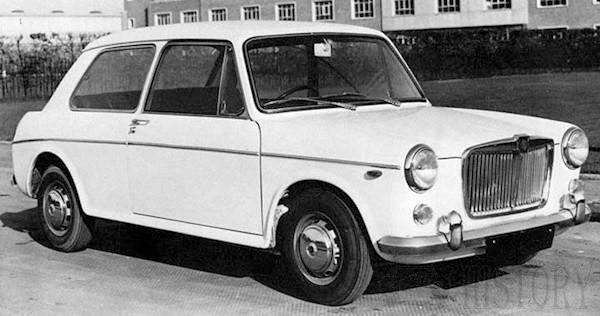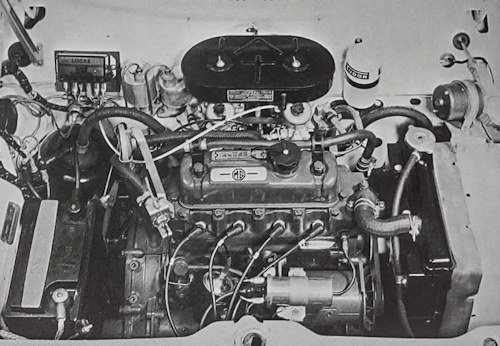MG 1100 and 1300 Mark II (BMC ADO16)
 |
|
|
Production: |
1967 to 1971 |
|
Class: |
Motor Car |
|
Engine: |
1.1 L-1.3 L |
|
Wheel base: |
93.50 in, 2,375 mm |
| Overall length: | 60.35 in, 1,533 mm |
| Overall height: | 53 in, 1,346 mm |
| Overall width: | 60.35 in, 1,533 mm |
| Dry weight: | 1,621 1b, 735 kg |
The Mark II MG 1100 and 1300 were built from 1967 to 1971 in home markets.
History
At the end of May 1967, BMC announced the fitting of a larger 1275 cc engine to the MG two and four-door family car variants. The new car combined the 1275 cc engine block already familiar to drivers of newer Mini Cooper S and Austin-Healey Sprite models with the 1100 transmission, its gear ratios remaining unchanged for the larger engine, but the final-drive being significantly more highly geared.distribution of weight was 61.4% to front axle,and 38.6% at rear axle.Front suspension was independent type with , wishbones, hydrolastic (liquid) rubber cone springs, hydraulic connecting pipes to rear wheels,with rear suspension also independent, swinging longitudinal trailing arms, hydrolastic (liquid) rubber cone springs, hydraulic connecting pipes to front wheels, combined with transverse torsion bars and anti-roll bar.
The Mark II versions built as the MG 1300 and an 1100 version of the Mark II continued alongside the larger-engine models.On the outside, a slightly wider front grille, extending a little beneath the headlights, and with more detailing. BMC engineers redesigned the MG-1100, adding the 1275 cc engine already seen in the Austin Mini Cooper, but with a lower power level (56 and 65 hp instead of 76) and a more elegant and sporty appearance. The elegant front metal grill was the main hallmark of this vehicle.Optional Accessories
for the MG include reclining backrests; AP Automatic gearbox, hydraulic torque convertor with 2 conic bevel gears (twin concentric differential-like gear clusters) with 4 ratios operated by 3 brake bands and 2 multi-disc clutches.

Unusually for cars at this end of the market, domestic market waiting lists of several months accumulated for the 1300-engined cars during the closing months of 1967 and well into 1968.The manufacturers explained that following the devaluation of the British Pound in the Fall / Autumn of 1967 they were working flat out to satisfy export market demands.
PERFORMANCE :1300cc
- Engine Capacity 77.80 cu in, 1,275 cu cm
- Fuel Consumption 32.5 m/imp gal, 27 m/US gal, 8.7 1 x 100 km
- Max Speed 97 mph, 156.2 km/h
- max power (DIN): 70 hp at 6,000 rpm
- max torque (DIN): 77 1b ft, 10.7 kg m at 3,000 rpm
- max engine rpm: 6,000
- specific power: 54.9 hp/l
- max speeds: 30 mph, 48.3 km/h in 1st gear
- 49 mph, 78.9 km/h in 2nd gear
- 74.5 mph, 119.9 km/h in 3rd gear
- 97 mph, 156.2 km/h in 4th gear
- power-weight ratio: 23.2 lb/hp, 10.5 kg/hp
- acceleration: standing 1/4 mile 19.6 sec, 0—50 mph (0—80 km/h) 9.4 sec
Mark II versions of the MG introduced in October 1968.The MG, car was sold also in In Spain. In Denmark the MG models were sold as the MG Sports Sedan there, as it was in North America from 1962, and was available with a two-door bodyshell that would not be available in the UK until 1968. The Vanden Plas Princess was briefly the MG Princess 1100 in North America. Versions of MG were assembled in New Zealand from CKD kits from 1963 until the final versions were replaced by the Allegro in 1975.
The exported cars had a metal body structure; although in some countries like Chile a two-door fiberglass version was built, they were made of fiberglass. The fiberglass versions turned out to be 15% heavier than the metal ones, but they did not rust in coastal areas and were resistant to low-energy shocks. These rare versions built until around 1975, Some shortcomings of the fiberglass version were that it was not completely rainproof, so its trunk could be flooded, leaving the electric fuel pump located inside easily vulnerable to faults.
Technical
-
MG 1100 1300 Mark II Technical details and specifications (1967-1971)
ENGINE:1300cc
location front, 4 stroke, transverse
cylinders: 4, vertical, in line
bore and stroke : 2.78 x 3.20 in, 70.6 x 81.3 mm
engine capacity: 77.80 cu in, 1,275 cu cm
compression ratio: 9.7
cylinder block: cast iron
cylinder head: cast iron
cranskhaft bearings: 3
valves: 2 per cylinder, overhead, in line, push-rods and rockers
camshafts: 1, side
lubrication: gear or vane-type pump, full flow filter
lubricating system capacity: 9 imp pt, 10.78 US pt, 5.1 1
carburation: 2 SU type HS 2 semi-downdraught carburettors
fuel feed : electric pump
cooling system: water
TRANSMISSION
driving wheels: front
clutch: single dry plate (diaphragm), hydraulically controlled
gearbox: mechanical; gears: 4 + reverse
synchromesh 1st, 3rd, 4th
gearbox ratios: I 3.300, II 2.074, III 1.353, IV 1, rev 3.350
(option) Automatic gearbox, with 2 conic bevel gears (twin concentric differential-like gear clusters)
Automatic 4 ratios (I 2.612, II 1.807, III 1.446, IV 1, rev 2.612)
gear lever location: central
final drive: helical spur gears
axle ratio: 3.650.CHASSIS
type integral, front and rear auxiliary frames
front suspension: independent, wishbones, hydrolastic (liquid) rubber cone springs, hydraulic connecting pipes to rear wheels
rear suspension: independent, swinging longitudinal trailing arms, hydrolastic (liquid) rubber cone springs, hydraulic connecting pipes to front wheels, combined with transverse torsion bars, anti-roll bar.STEERING
rack-and-pinion
turns of steering wheel lock to lock: 3.30.
turning circle (between walls): 37.5 ft, 11.4 mBRAKES
front disc (diameter 8.40 in, 213 mm)
rear drum
area rubbed by linings: front 143 sq in, 922.35 sq cm
area rubbed by linings: rear 63 sq in, 406.35 sq cm
area rubbed by linings: total 206 sq in, 1 ,328.70 sq cm.ELECTRICAL EQUIPMENT
voltage: 12 V
battery: 40 Ah
generator type: dynamo, 264 W
ignition distributor: LucasDIMENSIONS AND WEIGHT
wheel base: 93.50 in, 2,375 mm
front track: 51.50 in, 1,308 mm
rear track: 50.85 in, 1,292 mm
overall length: 146.75 in, 3,727 mm
overall width: 60.35 in, 1,533 mm
overall height: 53 in, 1,346 mm
ground clearance: 5.30 in, 135 mm
dry weight: 1,621 1b, 735 kg
distribution of weight: 61.4% front axle, 38.6% rear axle© Motor car History
Service
-
MG 1100 1300 Mark II maintenance and Service Guide (1967-1971)
Greasing: every 3,000 miles, 4,800 km, 4 points
Normal tyre pressure: front 28 psi, 2 atm, rear 24 psi, 1.7 atm.
Tyres: 145 x 12
Fuel tank capacity: 8 imp gal, 9.5 US gal
Carrying capacity: 882 1b, 400 kgEngine: 1300cc
Fuel type: 100 oct petrol
Engine, gearbox and final drive oil: 8.50 imp pt, 10.15 US pt, 4.8 1, SAE 20W-50, change avery 6,000 miles, 9,700 km
Cooling system capacity: 6.80 imp pt, 8.24 US pt.
Cpark plug type: 2250
Tappet clearances: inlet 0.012 in, 0.30 mm, exhaust 0.012 in, 0.30 mm
Valve timing: inlet opens 5° before tdc and closes 45° after bdc, exhaust opens 51° before bdc and closes 21° after tdc© Motor car History
